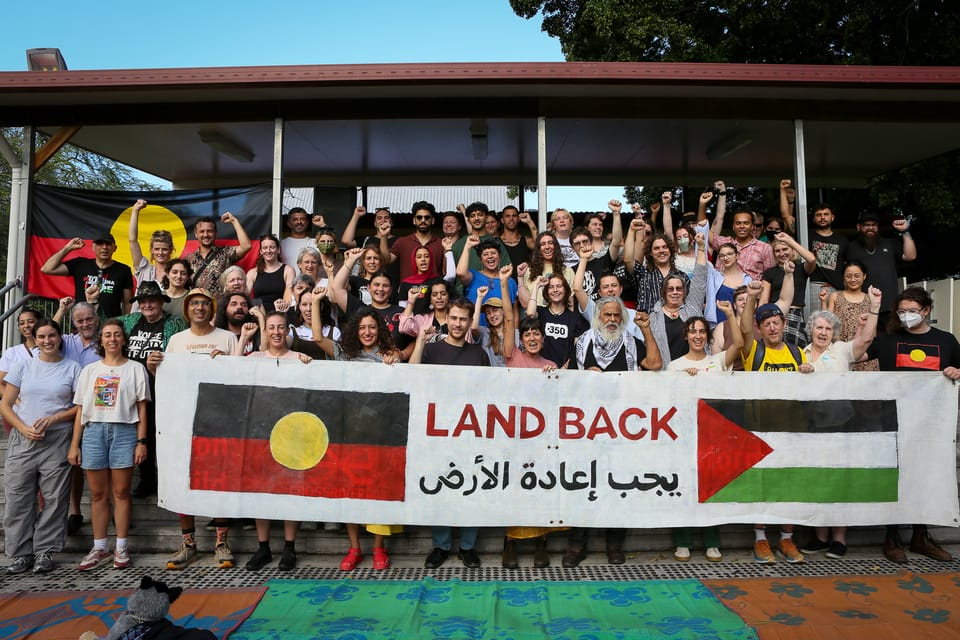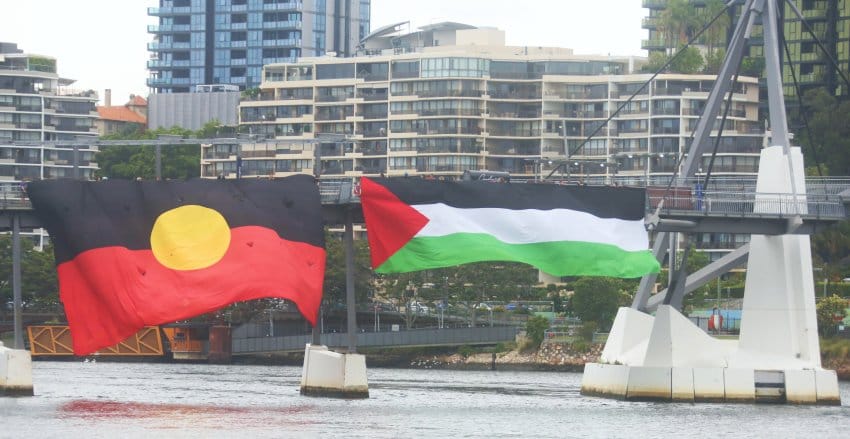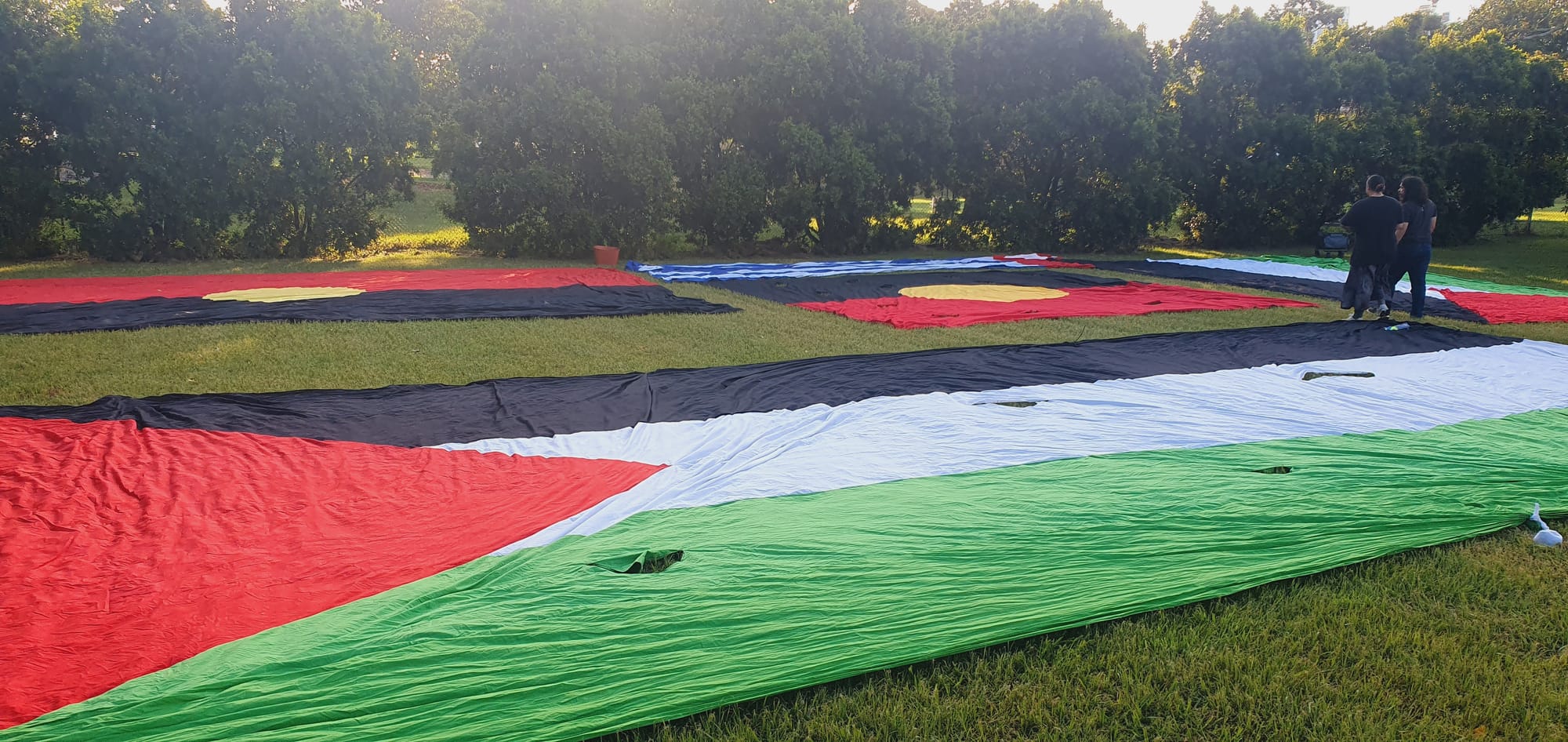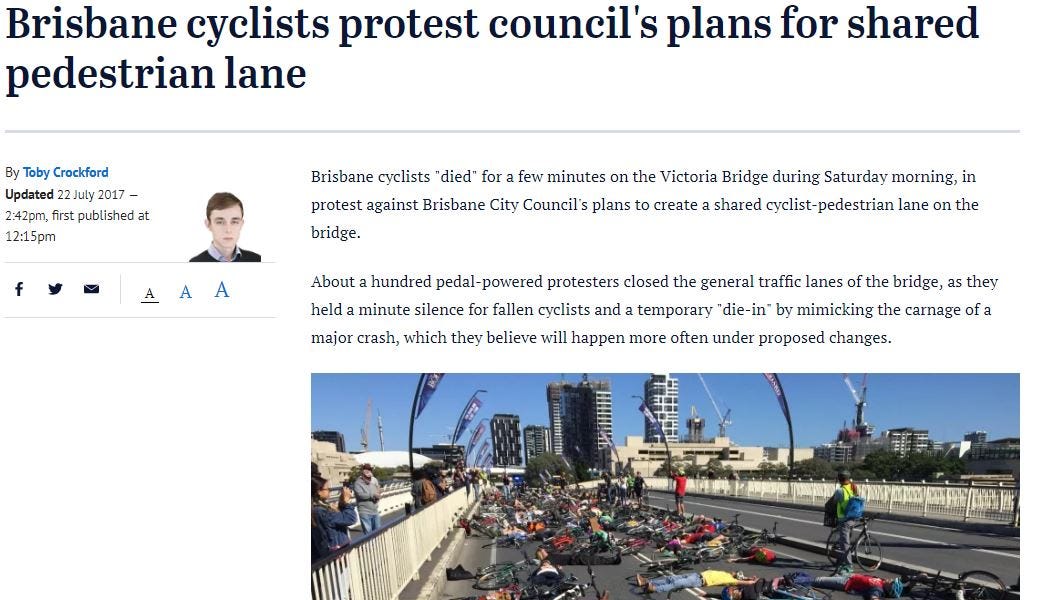Banner drop skillshare: How to hang a giant flag off a bridge safely and effectively

These notes have been compiled from a skillshare session in early 2025 as part of an afternoon of workshops in Musgrave Park, Kurilpa called ‘The Last Sunset.’ This convergence of activists and community organisers was organised by volunteers through the Institute of Collaborative Race Research. This article doesn't cover how to make and sew together large banners (but you can easily find other resources online covering that).
Hanging a large protest banner or a flag from a bridge or monument is an effective and reasonably simple tactic to draw attention to a cause or show solidarity with a particular struggle.

Here are a few tips that might be useful for anyone planning an action like this...
Prepping your banner
When hanging large banners (more than around 5m x 5m) off structures where they won’t have a solid wall behind them, it’s important to add some weights to the bottom and cut flaps/holes for the wind.
For a bigger banner – e.g. 10m x 15m – you usually only need 1 or 2 kilograms of weight in total along the bottom to stop it blowing in the wind too much. Common options are bean bags, tennis balls, or even stitching rice into the seams, but don’t overdo it. Too much weight can tear the fabric. Make sure the weights are spread evenly along the bottom edge.

Flaps will allow wind gusts to pass through the banner without pulling on it like a sail. Without holes or wind flaps, if we hang a giant flag off a bridge, strong gusts can either push the banner under the bridge, or back up over the top, making it difficult to get a good photo. Every 1.5 to 2m along the middle of the banner, cut a semi-circular flap that’s about 20cm in diameter. If your banner is really tall, hanging more than 10 metres down from the bridge, cut multiple rows of wind flaps. Ideally, you should stitch seams around the edges of the flaps once you’ve sewn them, otherwise the cut fabric is more likely to tear when it’s under tension.
To assist with transport and unfurling, make sure you've sewn eyelets or ropes into the top edge of the banner.
@jonnosri #FreePalestine #freewestpapua #alwayswasalwayswillbeaboriginalland
♬ original sound - Jonathan Sriranganathan
Unfurling your banner
Before dropping, the banner should be neatly rolled up from the bottom so that when it’s released, it unfurls smoothly. The people deploying it should be evenly spaced along its length and agree beforehand on clear directions and signals for when to drop it and when to pull it in.
Holding a large, heavy banner in the wind can be tiring on forearms and fingers. Experienced organisers recommend that before unfurling, you secure the top edge of the banner to a railing or bridge. Magandjin crew prefer reusable cable ties that can be quickly attached, tightened and removed without waste. If tying with rope or string, make sure you have multiple pocket knives and pairs of scissors handy just in case you need to cut stuff loose in a hurry.
One of the organisers leading our Last Sunset workshop said they still keep a loose grip on the banner even once it's securely tied off.

Other stuff to plan for
Lining up people to visually document the action is important. Assign at least one volunteer to take photos and another to capture video, and remind them to make sure their phones/camera batteries are properly charged. Get a third volunteer to livestream if you have the numbers. Scout the locations you want to photograph from in advance to make sure there's clear line of sight.
Make sure your photographers are in direct contact with those on the bridge so they can confirm when they've taken enough footage/images, and also so they can alert bridge volunteers if anything needs correcting (e.g. if a corner of the banner hasn't unfurled properly and it needs to be pulled in and redeployed). Bridge volunteers who are responsible for maintaining phone contact with photographers and scouts are advised to bring headphones so they can keep their hands free while on calls.
Assign someone on the bridge to liaise with any cops or security guards who show up, and ensure other volunteers understand they should direct any approaching government officials to speak to the police liaison. If you're worried about police repression and anticipate needing to make a quick getaway, placing scouts at either end of the bridge who can see police coming and phone through warnings is worthwhile.
If a banner drops from a bridge and no-one's there to see it...
Actions like these are all about getting solid visuals that travel across multiple mediums, so make sure you have a thorough plan for what socials channels you'll be distributing on, and plenty of mates lined up to hit share and spread your images further. There's little value going to all the trouble of making and displaying a giant banner/flag if the image just sits on a dying Facebook page that no-one ever visits.
Banner drops don't require large numbers of volunteers, and are generally less polarising than other, more disruptive forms of activism, but are great for raising consciousness and boosting morale. So don't second-guess yourself. Get out there and organise one!

Shout-outs again to the Institute for Collaborative Race Research for creating a space where organisers could share skills and ideas.
I produce a monthly newsletter featuring upcoming local events and articles about activism, green politics and radical urbanism/municipalism, focusing mostly on the Maiwar Valley region and broader South-East Queensland/Northern NSW. Subscribe for free to stay in the loop...
Queensland-based direct action organisers might also be interested in this article about the rules for holding street marches and large public rallies...







Member discussion